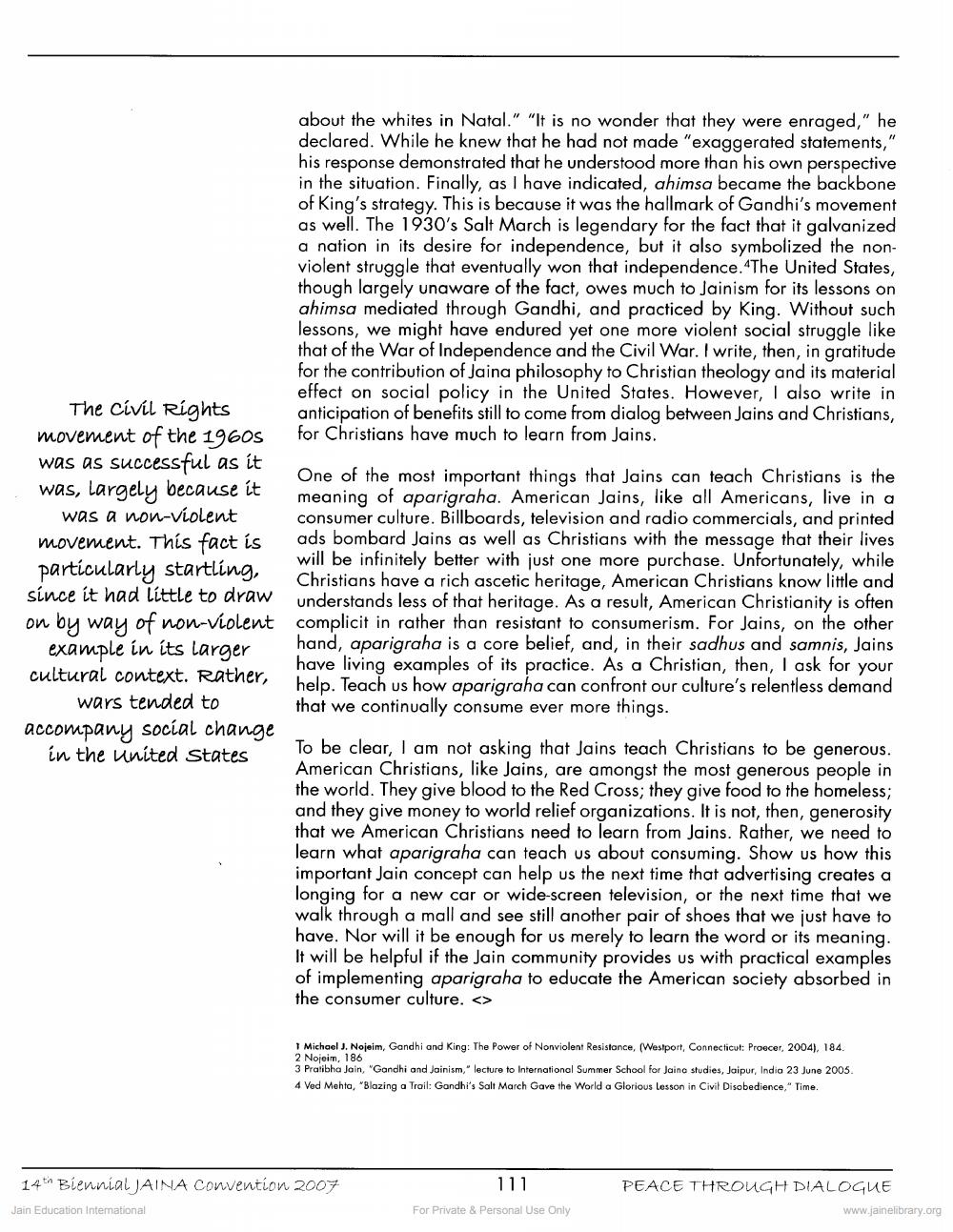________________
about the whites in Natal." "It is no wonder that they were enraged," he declared. While he knew that he had not made "exaggerated statements," his response demonstrated that he understood more than his own perspective in the situation. Finally, as I have indicated, ahimsa became the backbone of King's strategy. This is because it was the hallmark of Gandhi's movement as well. The 1930's Salt March is legendary for the fact that it galvanized a nation in its desire for independence, but it also symbolized the nonviolent struggle that eventually won that independence. The United States, though largely unaware of the fact, owes much to Jainism for its lessons on ahimsa mediated through Gandhi, and practiced by King. Without such lessons, we might have endured yet one more violent social struggle like that of the War of Independence and the Civil War. I write, then, in gratitude for the contribution of Jaina philosophy to Christian theology and its material
effect on social policy in the United States. However, I also write in The Civil Rights anticipation of benefits still to come from dialog between Jains and Christians, movement of the 1960s for Christians have much to learn from Jains. was as successful as it
One of the most important things that Jains can teach Christians is the was, largely because it
meaning of aparigraha. American Jains, like all Americans, live in a was a non-violent consumer culture. Billboards, television and radio commercials, and printed movement. This fact is ads bombard Jains as well as Christians with the message that their lives
will be infinitely better with just one more purchase. Unfortunately, while particularly startling,
Christians have a rich ascetic heritage, American Christians know little and
understands less of that heritage. As a result, American Christianity is often on by way of non-violent complicit in rather than resistant to consumerism. For Jains, on the other example in its larger
hand, aparigraha is a core belief, and, in their sadhus and samnis, Jains
have living examples of its practice. As a Christian, then, I ask for your cultural context. Rather, hely
help. Teach us how aparigraha can confront our culture's relentless demand wars tended to
that we continually consume ever more things. accompany social change in the United States
To be clear, I am not asking that Jains teach Christians to be generous. American Christians, like Jains, are amongst the most generous people in the world. They give blood to the Red Cross; they give food to the homeless; and they give money to world relief organizations. It is not, then, generosity that we American Christians need to learn from Jains. Rather, we need to learn what aparigraha can teach us about consuming. Show us how this important Jain concept can help us the next time that advertising creates a longing for a new car or wide-screen television, or the next time that we walk through a mall and see still another pair of shoes that we just have to have. Nor will it be enough for us merely to learn the word or its meaning. It will be helpful if the Jain community provides us with practical examples of implementing aparigraha to educate the American society absorbed in the consumer culture. <>
1 Michael J. Nojeim, Gandhi and King: The Power of Nonviolent Resistance, (Westport, Connecticut: Proscer, 2004), 184. 2 Nojeim, 186 3 Pratibha Jain, "Gandhi and Jainism," lecture to International Summer School for Jaina studies, Jaipur, India 23 June 2005. 4 Ved Mehta, "Blazing a Trail: Gandhi's Salt March Gave the World a Glorious lesson in Civil Disobedience," Time,
14th Biennial JAINA Convention 2007
111
PEACE THROUGH DIALOGUE
www.jainelibrary.org
Jain Education Intemational
For Private & Personal Use Only




